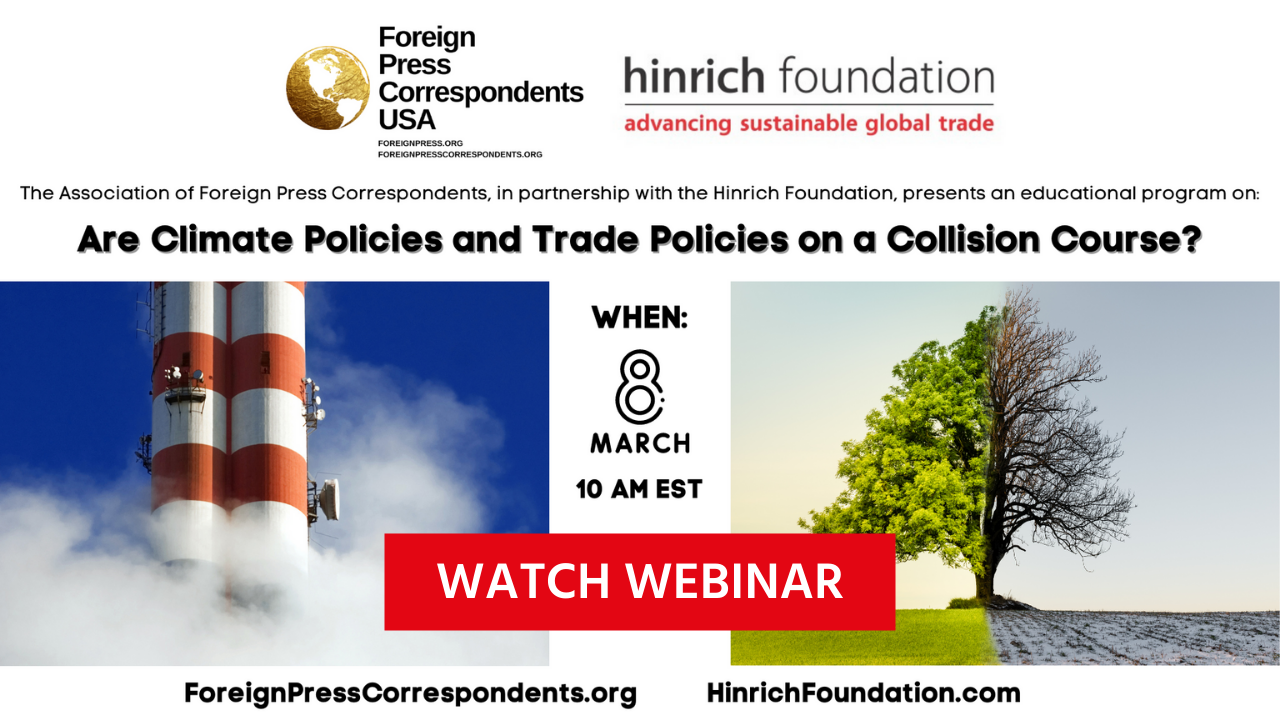Are climate policies and trade policies on a collision course?
Published 15 March 2022
In many countries, the growing complexities of balancing economic development with climate commitments are manifested in the move to greater trade sustainability. What are the key challenges policymakers must face when mapping green industrial policy objectives and trade objectives? Two experts shared their views in this Hinrich Foundation supported webinar.
Watch the full discussion here:
In this hour-long discussion hosted by the Association of Foreign Press Correspondents, Stephen Olson of the Hinrich Foundation and Aaron Cosbey of the International Institute for Sustainable Development touched on issues within trade governance and what form increasing tensions between climate and trade objectives might take. Does carbon pricing run contrary to the foundational concepts of our global trade system? How could uneven climate ambitions and the use of industrial subsidies impair trade relations? Read a summary of the key takeaways:
On the “collision course” between trade and climate policies:
Climate change has made clear “how difficult it is going to be to reconcile our trade governance... with our climate and environmental goals,” says Olson, who, along with Cosbey, points out that:
- CBAM would raise WTO compliance questions, motivating countries to file dispute settlement cases.
- There are multiple “flashpoint” issues, such as the implementation of subsidies and incentives to purchase electric vehicles produced in the United States, that are “good news” from an environmental point of view but that risk impairing relationships with the trade ministers of Canada and Mexico and could be construed as a flouting of US obligations under the United States–Mexico–Canada Agreement (USMCA), which proposed the creation of “a single North American production base in the automobile industry.”
- “Wrapping up” carbon prices domestically demands that you also compensate for the fact that you put domestic producers at the risk of “leakage” because climate change emissions increase due to industries relocating elsewhere, undermining efforts to respond to climate change on a global scale.
- Complainants to the WTO will ultimately fail to change measures like CBAM.
On the role of the WTO
- While it is true that nations cannot discriminate between products under the General Agreement on Tariffs and Trade (GATT), it is also true that there exist exceptions for certain types of regulations, such as environmental ones, that countries have acknowledged supersede other obligations under GATT.
- In the long term, the WTO may be forced to contend with an organization-wide legitimacy crisis amplified by “years of erosion of trust in multilateralism.”
- Reforming the WTO has proven difficult because the organization is full of "broad, vague, self-judging exceptions that have never been tested before" and it is difficult to reach a consensus between nations of varying degrees of development.
Key questions
Olson explores the importance of trade considerations between climate policy and environmental objectives, stressing the “complexity” of navigating countries’ individual systems and the resulting administrative burden that will culminate in “major trade issues” that would deal significant damage to small-to-medium enterprise.
Cosbey explores how there is a “fundamental crisis” on the question of dealing with “sticks,” defined as carbon pricing and regulation, and a less obvious one on the question of “carrots,” long-term policies such as the Biden administration’s reworked Build Back Better (BBB) initiative, underscoring the tension between green industrial policy objectives and trade objectives.
© The Hinrich Foundation. See our website Terms and conditions for our copyright and reprint policy. All statements of fact and the views, conclusions and recommendations expressed in this publication are the sole responsibility of the author(s).

